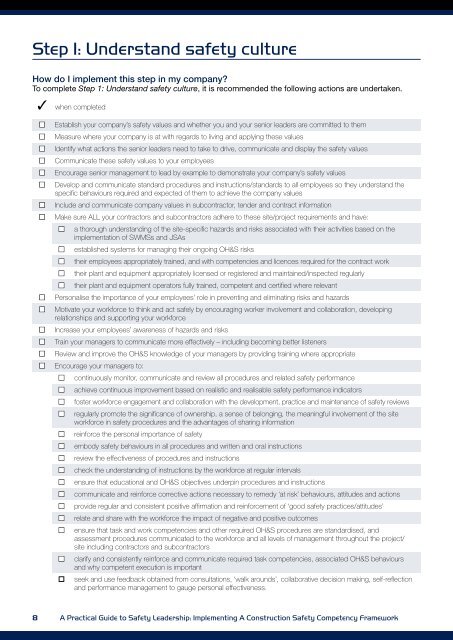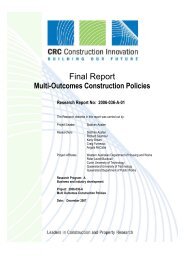A Practical Guide to Safety Leadership Book (PDF 5MB) - QUT ePrints
A Practical Guide to Safety Leadership Book (PDF 5MB) - QUT ePrints
A Practical Guide to Safety Leadership Book (PDF 5MB) - QUT ePrints
Create successful ePaper yourself
Turn your PDF publications into a flip-book with our unique Google optimized e-Paper software.
Step 1: Understand safety culture<br />
How do I implement this step in my company?<br />
To complete Step 1: Understand safety culture, it is recommended the following actions are undertaken.<br />
when completed<br />
■<br />
■<br />
■<br />
■<br />
■<br />
■<br />
■<br />
■<br />
■<br />
■<br />
■<br />
■<br />
■<br />
■<br />
Establish your company’s safety values and whether you and your senior leaders are committed <strong>to</strong> them<br />
Measure where your company is at with regards <strong>to</strong> living and applying these values<br />
Identify what actions the senior leaders need <strong>to</strong> take <strong>to</strong> drive, communicate and display the safety values<br />
Communicate these safety values <strong>to</strong> your employees<br />
Encourage senior management <strong>to</strong> lead by example <strong>to</strong> demonstrate your company’s safety values<br />
Develop and communicate standard procedures and instructions/standards <strong>to</strong> all employees so they understand the<br />
specific behaviours required and expected of them <strong>to</strong> achieve the company values<br />
Include and communicate company values in subcontrac<strong>to</strong>r, tender and contract information<br />
Make sure ALL your contrac<strong>to</strong>rs and subcontrac<strong>to</strong>rs adhere <strong>to</strong> these site/project requirements and have:<br />
■<br />
■<br />
■<br />
■<br />
■<br />
a thorough understanding of the site-specific hazards and risks associated with their activities based on the<br />
implementation of SWMSs and JSAs<br />
established systems for managing their ongoing OH&S risks<br />
their employees appropriately trained, and with competencies and licences required for the contract work<br />
their plant and equipment appropriately licensed or registered and maintained/inspected regularly<br />
their plant and equipment opera<strong>to</strong>rs fully trained, competent and certified where relevant<br />
Personalise the importance of your employees’ role in preventing and eliminating risks and hazards<br />
Motivate your workforce <strong>to</strong> think and act safely by encouraging worker involvement and collaboration, developing<br />
relationships and supporting your workforce<br />
Increase your employees’ awareness of hazards and risks<br />
Train your managers <strong>to</strong> communicate more effectively – including becoming better listeners<br />
Review and improve the OH&S knowledge of your managers by providing training where appropriate<br />
Encourage your managers <strong>to</strong>:<br />
■<br />
■<br />
■<br />
■<br />
■<br />
■<br />
■<br />
■<br />
■<br />
■<br />
■<br />
■<br />
■<br />
■<br />
continuously moni<strong>to</strong>r, communicate and review all procedures and related safety performance<br />
achieve continuous improvement based on realistic and realisable safety performance indica<strong>to</strong>rs<br />
foster workforce engagement and collaboration with the development, practice and maintenance of safety reviews<br />
regularly promote the significance of ownership, a sense of belonging, the meaningful involvement of the site<br />
workforce in safety procedures and the advantages of sharing information<br />
reinforce the personal importance of safety<br />
embody safety behaviours in all procedures and written and oral instructions<br />
review the effectiveness of procedures and instructions<br />
check the understanding of instructions by the workforce at regular intervals<br />
ensure that educational and OH&S objectives underpin procedures and instructions<br />
communicate and reinforce corrective actions necessary <strong>to</strong> remedy ‘at risk’ behaviours, attitudes and actions<br />
provide regular and consistent positive affirmation and reinforcement of ‘good safety practices/attitudes’<br />
relate and share with the workforce the impact of negative and positive outcomes<br />
ensure that task and work competencies and other required OH&S procedures are standardised, and<br />
assessment procedures communicated <strong>to</strong> the workforce and all levels of management throughout the project/<br />
site including contrac<strong>to</strong>rs and subcontrac<strong>to</strong>rs<br />
clarify and consistently reinforce and communicate required task competencies, associated OH&S behaviours<br />
and why competent execution is important<br />
seek and use feedback obtained from consultations, ‘walk arounds’, collaborative decision making, self-reflection<br />
and performance management <strong>to</strong> gauge personal effectiveness.<br />
8 A <strong>Practical</strong> <strong>Guide</strong> <strong>to</strong> <strong>Safety</strong> <strong>Leadership</strong>: Implementing A Construction <strong>Safety</strong> Competency Framework

















